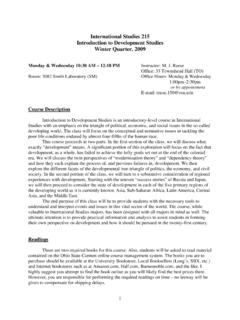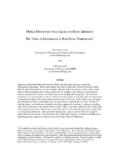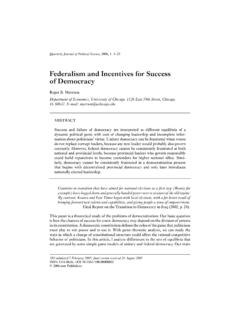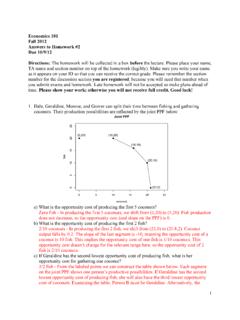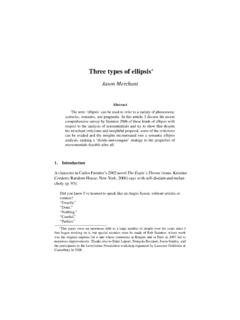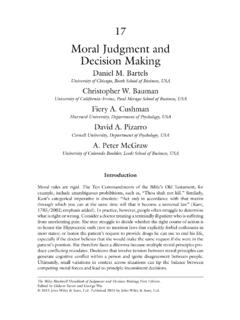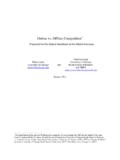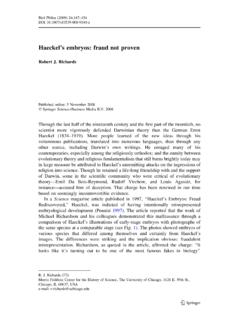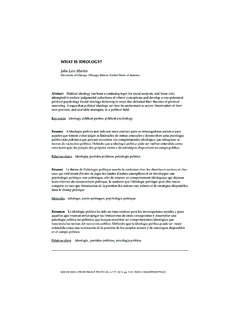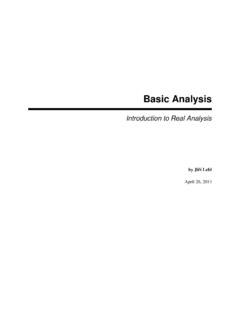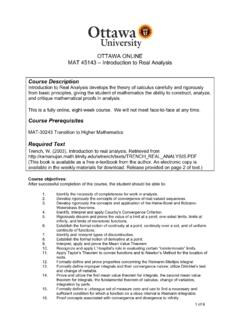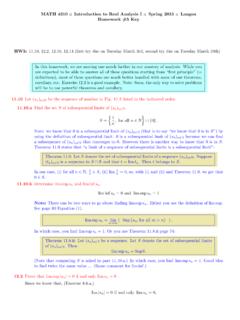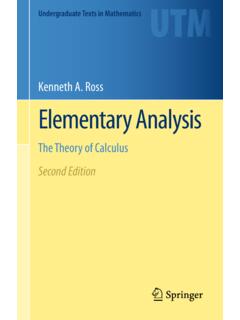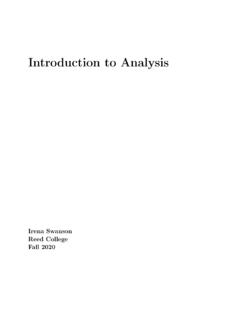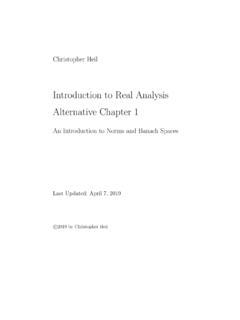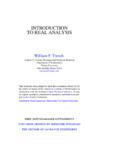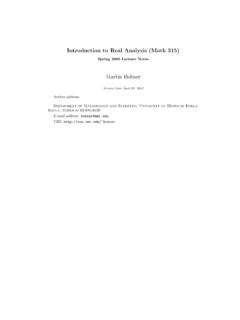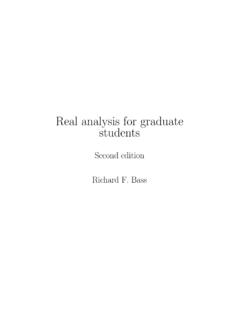Transcription of KEY CONCEPTS: Introduction to Real Analysis
1 KEY CONCEPTS: Introduction to RealAnalysisSamvel Atayan and Brent HickmanSummer 20081 Sets and FunctionsPRELIMINARY NOTE: Many definitions given in these notes are framed interms specific to the real numbers. This simplifies matters greatly becauseof the familiar ordering and distance concepts which come asstandard fea-tures in (finite-dimensional) Euclidean space. However, many of the conceptsgiven below have useful analogs in more exotic spaces ( , spaces of func-tions or spaces of infinite sequences), but those require some knowledge ofmetric topology, which will be a major emphasis of your Economic Analysis I(06E:200) class. For the purpose of math camp, we will resignourselves tothe quaint shackles of Euclidean SetsDefinition 1 Asetis a collection of elements. If an elementxis in a setAthen we denotex A,ifxis not inA,then we writex / A If every element of a setAis also in setB, thenAis a subset ofBandwe denote this asA BorB A.
2 Ais aproper subsetofBif there is at least one element inBthat isnot inA. We denote this byA BorB A. Twosets are equalif they contain all the same elements:A= is,A BandB A set is defined by listing its elements or by specifying the propertythat determines the elements of the set:{x A:P(x)},wherePissome property. Examples: Natural numbers:N={1,2,3, ..} Integers:Z={0,1, 1,2, 2, ..} Rational numbers:Q={mn:m, n Zandn6= 0} real numbers:R S={2k:k N} Set operations Theunionof setsAandBis the setA B={x:x Aorx B} Theintersectionof the setsAandBis the setA B={x:x Aandx B} ThecomplementofBrelative toA(or thedifferencebetweenAandB) is the setA\B={x:x Aandx / B} A set with no elements is called theempty setand is denoted by . Two sets aredisjointif they have no elements in common:A B= . DeMorgan laws:A\(B C) = (A\B) (A\C)A\(B C) = (A\B) (A\C) For a countable collection of sets{A1, A2.}
3 , An, ..}:2 union: n=1An={x:x Anfor somen N} intersection: n=1An={x:x Anfor alln N} Cartesian productof two sets is a set of all ordered pairs:A B={(a, b) :a A, b B} Aballof radius aroundxinRis a set defined byB (x) ={y R:|x y|< } For a setA, alimit pointofAis a pointl Rsuch that for each >0, there exists somey Asuch thaty B (x). Functions and Mappings Afunctionffrom a setAinto a setB, denotedf:A B, is a setfof ordered pairs inA Bsuch that for eachx Athere exist a uniqueb Bwith (a, b) f. The setAof first elements of functionfis called thedomainoffand is denotedD(f). The setBof all second elements infis calledtherangeoffand is denoted byR(f). Note thatD(f) =A, whileR(f) the following, consider a functionf, mappingAintoB. LetE A,then thedirect imageofEunderfis the subsetf(E) Bgiven byf(E) ={f(x) :x E}LetH B,then theinverse imageofHunderfis the subsetf 1(H) Agiven byf 1(H) ={x A:f(x) H}3 The functionfisinjective (one-to-one)if wheneverx16=x2thenf(x1)6=f(x2).
4 The functionfissurjective (onto)iff(A) =B. That is,R(f) = both injective and surjective then it isbijective. Iff:A Bis a bijection ofAontoB, thenf 1={(b, a) B A: (a, b) f}is a function mappingBintoA, called theinverseoff. IMPORTANT NOTE: inverse images always exist; inverse func-tions exist ONLY for bijections. Iff:A Bandg:B C,and ifR(f) D(g) =B,then thecomposite functiong fis the function fromAintoCdefined by(g f)(x) =g(f(x)) for allx ATheorem 1 Letf:A Bandg:B Cbe functions and letH (g f) 1(H) =f 1(g 1(H)) Finite, infinite, and countable sets The empty set has zero elements Ifn N,a setAhasnelements if there exist a bijection fromNn={1, .., n}ontoA. A setAisfiniteif it either empty or it hasnelements for somen N A setAisinfiniteif it is not 2 Suppose thatSandTare sets and thatT ifSis a finite set, thenTis a finite set2.
5 IfTis an infinite set, thenSis an infinite set4 A setSisdenumerable (countably infinite)if there exists a bijec-tion ofNontoS. A setSiscountableif it is either finite or denumerable A setSisuncountableif it is not 3 Suppose thatSandTare sets and thatT ifSis a countable set, thenTis a countable set2. IfTis an uncountable set, thenSis an uncountable setExercise 1 Prove thatZis a countable 2 Prove thatQis a countable 3 Prove thatR\Qis an uncountable set (HINT: proceed by contra-diction and use the fact that the irrationals are expressed by non terminating,non repeating decimals, with comparisons being performedin lexicographicfashion).Theorem 4 The countable union of countable sets is countable is countable. A setS Tis said to bedenseinTif for any two members ofT,sayxandy, there existss Ssuch thatx < s < 4 Prove thatQis dense in 5 Prove thatQis dense inR(HINT: use the familiar lexicographicrepresentation of real numbers).
6 Exercise 6 Prove thatR\Qis dense inR(HINT: use the familiar lexico-graphic representation of real numbers).52 The completeness property ofRNow we consider the set of real numbers. LetS RandS6= . Then1. The setSisbounded aboveif there exist a numberu Rsuchthats ufor alls each such u is anupper The setSisbounded belowif there exists a numberw Rsuchthatw sfor alls suchwis called alower A setSisboundedif it is both bounded above and below. A setisunboundedif it is not bounded. LetS RandS6= .IfSis bounded above, then a numberuis asupremum(or a leastupper bound, ) an upper bound ofS,and2. ifvis any upper bound ofS,thenu vIfSis bounded below, then a numberwis aninfimum(or a greatestlower bound, ) a lower bound ofS, and2. ifris any lower bound ofS, thenr that there is only one supremum (infimum) of a given setS setSshould have upper (lower) bound in order to have the supremum(infimum).
7 It does not have to be an element of the setS. Also, it is :supSandinfSLemma 1An upper bounduof a nonempty setS Ris the supremum ofSif and only if for every >0there exist ans Ssuch thatu < s 6 Theorem 5 The Completeness Property ofR/Supremum nonempty set of real numbers that has an upper bound also hasa supremum the range of the functionf:D R. Thenfisbounded aboveif the setf(D) ={f(x) :x D}is boundedabove inR. That is, there existB Rsuch thatf(x) Bfor allx D. Thenfisbounded belowif the setf(D) ={f(x) :x D}is boundedbelow inR. Thenfisboundedif it is bounded above and below. That is, B Rsuch that|f(x)| Bfor x properties: Iff(x) g(x)for allx D,thensupx Df(x) supx Dg(x) Iff(x) g(y)for allx, y D,thensupx Df(x) infy Dg(y) The Archimedean PropertyTheorem 6 Archimedean PropertyIfx Rthen there existnx Nsuch thatx < 1 IfS={1n|n N},theninfS= 0 Corollary 2 Ift >0, there existsnt Nsuch that0<1nt< t73 Limits of functionsDefinition 2 Supposef:A pandpis a limit point limit offasxapproachespis defined aslimx pf(x) =qif such pointqexists, and for every >0there exist >0such that if|p x|< then|f(x) q|<.
8 Theorem 7 Supposef, g:A Randlimx pf(x) =qandlimx pg(x) = p[f(x) +g(x)] =q+ p(f g)(x) = p(fg)(x) =qr,ifr6= 8(L Hopital s rules) Let a < b ,and functionsfandgare differentiable on(a, b)such thatg (x)6= 0for allx (a, b).Suppose thatlimx a+f(x) = 0 = limx a+g(x)1. a) iflimx a+f (x)g (x)=L R, thenlimx a+f(x)g(x)=Lb) iflimx a+f (x)g (x)=L { ,+ }, thenlimx a+f(x)g(x)=LSuppose thatlimx a+f(x) = = limx a+g(x)1. a) iflimx a+f (x)g (x)=L R, thenlimx a+f(x)g(x)=Lb) iflimx a+f (x)g (x)=L { ,+ }, thenlimx a+f(x)g(x)=LExercise 7 CRRA Preferences: use L Hopital s rules to show that prefer-ences given byc1 1 approach log preferences as Sequences Asequenceof real numbers is a functionf:N R. Therefore,the sequence can be denoted byf(1), f(2), ..Usually we denote thesequence by{xn} n=1, wherexn=f(n).
9 {1,12,13, ..}={1n} n=1{ 1,1, 1,1, 1, ..}={( 1)n} n=1bn=bfor n The Limit of a Sequence A sequence of real numbers{xn}is said toconvergeto pointx R,orxis alimitof{xn}if for every >0there existN Nsuch thatfor alln N we have|xn x|< .If sequence has a limit then it isconvergent, if it has no limit then :limn xn=xorxn xTheorem 9 Let{xn}be a sequence inR,and letx {xn}con-verges toxif and only if for any >0,B (x)aboutxexcludes at most afinite number of elements of{xn}.Exercise 8 Prove that a sequence can converge to at most one 1(a)lim(1n) = 0;(b)lim(1n2+1) = 0;(c)lim(3n+2n+1) = 3. In order to show that a sequence{xn}does not converge tox, we haveto find one number >0such that for anyN None can find aparticularn Nsuch that xnN x .Alternatively, we need onlyfind one >0, such thatB (x)excludes infinitely many members ofthe sequence.
10 Note, however, that showing that{xn}diverges is not Limit Theorems A sequence{xn}inRisboundedif there existsM RandM >0such that|xn| Mfor alln 10A convergent sequence inRis boundedTheorem 11 Let{xn}and{yn}be two sequences inRsuch thatxn xandyn the sequences{xn+yn},{xn yn},{xnyn},and{cxn}converge tox+y, x y, xy, cx, 12 Ifxn x,zn z,zn6= 0for alln Nandz6= 0, then thequotient sequence{xn/zn} 13If{xn}and{yn}are convergent sequences inRand ifxn ynfor alln N,thenlimn xn limn 14If{xn}is a convergent sequence inRand ifa xn bforalln N,thena limn xn 15 Let{xn},{yn},{zn}be sequences inR. Ifxn yn znfor alln Nandlimn xn= limn zn, then{yn}is convergent withlimn xn= limn yn= limn 9 Prove the above theoremTheorem 16 Ifxn x,then|xn| |x|.Exercise 10 Prove the above theoremTheorem 17 Letxn xandxn sequence{ xn} xExercise 11 Prove the above theoremTheorem 18 Letxnbe a sequence of positive real numbers such thatL=limn xn+1xnexists.
